Effects of application date and rate of foliar-applied glyphosate on pine seedlings in Turkey
Mehmet Can Cap •Derya Es¸en
Introduction
Herbaceous weeds compete with young tree seedlings for light,soil,water,nutrients and space and significantly reduce survival,growth and quality.Therefore,they are a major impediment to forest regeneration and in nursery production(McCarthy and O’Reilly 2001).By carrying out adequate weed control on sites where conifers grow,diameter and volume are significantly increased(Wagner et al.2004).
Weeds are controlled almost exclusively by manual or mechanical methods in Turkey(Saatc¸iog˘lu 1957;Es¸en and Yıldız 2000;Yildiz and Es¸en 2006;Yildiz et al.2007;Boydak and C¸alıs¸kan 2014).However,the temporary effectiveness on weeds and relatively high costs associated with manual and mechanical controls increasingly limit their use(Es¸en and Yıldız 2000;Es¸en and Zedaker 2004).As a result,herbicides are widely used for site preparation and conifer release in forest areas and for vegetation control in forest nurseries(McCarthy and O’Reilly 2001;Radosevich et al.2007).
Crop safety is a critical issue with chemical weed control(Ross and Lembi 1989;Radosevich et al.2007).Application rates and time are vital factors for herbicide phytotoxicity in pine seedlings(Newton and Knight 1981;Radosevich et al.2007).Currently,screening tests are being employed extensively in Europe and North America in order to rapidly assess herbicide phytotoxicity and species tolerance of many tree species(Bunn et al.1995;Ezel and Nelson 2001;Willoughby et al.2003;Woeste et al.2005;Mitchell et al.2006;Stanley et al.2014).Although a few screening tests for herbicide phytotoxicity in some hardwood species have been carried out in Turkey(Es¸en et al.2006,2012),no study has to date been conducted on screening for herbicide phytotoxicity and tolerance for the major conifer species of Turkey.
Glyphosate is the most widely used herbicide in forestry and in forest nurseries worldwide for vegetation management(Duryea and Landis 1984;Tanjung 2001;Thompson and Pitt 2003;Wagner et al.2004).It is a broad-spectrum,symplastically translocated herbicide to control many herbaceous and perennial weeds(Ross and Lembi 1989;Thompson and Pitt 2003;Duryea and Landis 1984).It is often used to release conifers from unwanted vegetation,including jack pine,(Pinus banksianaLamb),black spruce(PiceamarianaMill.),and white spruce(P.glaucaMoench.)(Thompson and Pitt 2003).Research indicates that the glyphosate tolerance of conifer seedlings varies by species and application times and rates(Prasad 1989;Tanjung 2001).There is,however,no information on the phytotoxicity of glyphosate on the major conifer species used in Turkish forestry,particularly taking application dates and rates into consideration.
This study aimed to determine the early effects of application dates and rates on the phytotoxicity of glyphosate to young containerized seedlings of Austrian pine(Pinus nigraJ.F.Arnold.),Scots pine(P.sylvestrisL.)and maritime pine(P.pinasterAiton),the conifer species commonly used forafforestation and supplementary plantings in Turkish forestry(Boydak and C¸alıs¸kan 2014;Anonymous 2014),and to help foresters to achieve effective,cost-efficient weed control in forested and nurseries areas.
Materials and methods
One-,two-,and three-year-old containerized seedlings of maritime pine(Izmit–Kefken origin),Austrian pine(Bolu–Sarpuncuk origin),and Scots pine(Bolu origin)were supplied by the Pınar Forest Nursery of the Du¨zce Directorate of Forestry in the Western Black Sea Region of Turkey.The maritime and Austrian pine seedlings were grown in 2.1 L polyethylene nursery bags,whereas the Scots pine seedlings were grown in 2.8 L bags.The growing medium consisted of 60%mineral soil,30%peat moss and 10%perlite.Seedlings received supplemental watering as needed during the study.The study employed 14 different treatments,including no weed control(NWC),manual weed control(MWC),and 12 herbicide weed control(HWC)treatments with different application rates and dates(Table 1).For the MWC treatment,herbaceous weeds growing in the containers were pulled out by hand in May 2014.Over-the-top application of glyphosate[N-(Phosphonomethyl)glycine, Roundup®Star SL(441 g l-1)]herbicide was applied to the pine seedlings to the point of run-off on three different dates(early April,May,and June 2014)using a 18-L CO2polyethylene plastic knapsack electric battery sprayer(Gardenjoy®,China)(Table 1).
Ground line diameter(GLD)and height of all seedlings were measured prior to treatments and at the end of the growing season,and seedling vigor(height-to-GLD ratio)was determined for each seedling.In addition,the effects of the treatments on the seedlings were also rated ocularly using a 1–6 point visual health index based on the degree of injury symptoms(i.e.,epinasty,chlorosis and necrosis)in the foliage prior to treatments and at the end of the growing season.Visual 1 designated dead seedlings with 100%crown necrosis,while Visual 6 described healthy seedlings with no visible morphological effects.The percent of seedling survival was calculated for each treatment for each species at the end of the growing season.
A randomized complete block design with four replications was used for the study.Each experimental unit contained 20 seedlings,and 1120 seedlings in total were used.Two sets of analyses were carried out;in the first set,data from all treatments,including NWC,MWC,and HWC applications,were analyzed using one-way ANOVA.In the second set,only HWC data were assessed using two-way ANOVA with application rate(AR)and application date(AD)as the main effects along with the AR×AD interaction effect(Ott 1993).In addition,the correlation of AR,including the control treatment(0%v:v)with the dependent variables(height,GLD,vigor(H/D),visual health index,and survival)was assessed in the third analysis across the ADs with three separate correlation analyses.
Means were separated using the Duncan mean separation test(MST)ata=0.05.Statistical analyses were carried out according to SAS(2008)and data were checked for violation of the ANOVA assumptions.
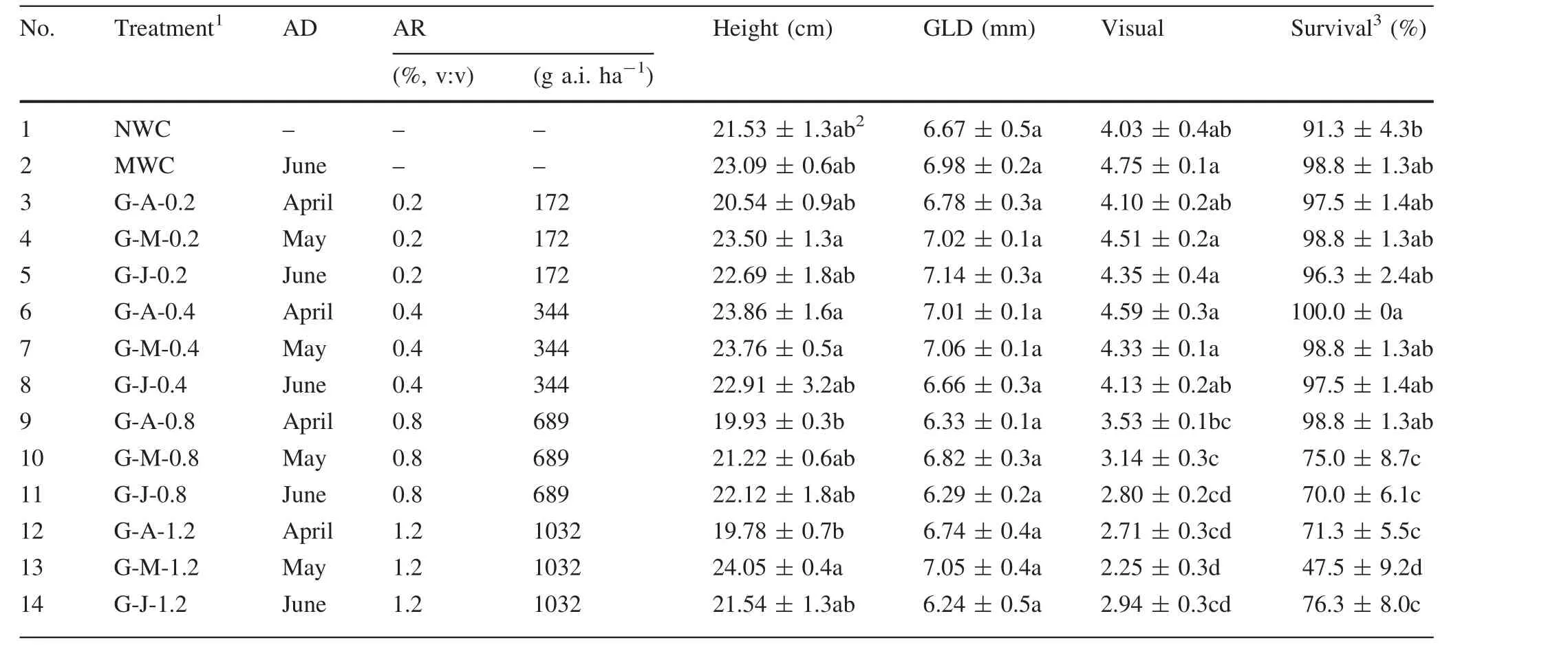
Table 1 Effects of no weed control(NWC),manual weed control(MWC)and 12 foliar-applied glyphosate treatments(HWC)with various application dates(AD)and rates(AR)on mean height,ground line diameter(GLD),visual health index at the end of the first growing season(Visual),and survival rate of the seedlings of Pinus nigra 1 year after treatment
Results and discussion
There were no signi ficant pre-treatment differences for any variables for any species.Mean pretreatment GLD and height were 3.06 mm and 11.33 cm for 1-year-old maritime pine seedlings,5.74 mm and 16.23 cm for 2-year-old Austrian pine seedlings,and 16.7 mm and 37.85 cm for 3-year-old Scots pine seedlings.
Austrian pine
In the first set of analyses,signi ficant differences were found for all dependent variables except for seedling vigor(H/D)(Table 1).Survival and the visual health index were generally high across treatments except for May/June applications at the high rate(0.8%)and the April,May,and June applications at the highest rate(1.2%).The April 0.4%application rate caused no seedling mortality,while the May application at the highest rate(1.2%)resulted in the lowest seedling survival.The highest glyphosate application applied in May significantly reduced the mean survival rate by more than 30,47 and 52%when compared to the June-0.8%,NWC,and April-0.4%treatments,respectively(Table 1).
In the second set of analyses,the AD was found to have had a signi ficant effect on mean height and vigor index(H/D)(Table 2).The seedlings sprayed in May averaged a significantly higher mean height(10%)than those sprayed in April,which averaged a significantly lower vigor index when compared to those sprayed in May and June.In addition,the main effect of AR was signi ficant for meanseedling heightand visualhealth index (Table 2).Increasing the rate in flicted greater damage on the seedlings.At the high(0.8%)and highest(1.2%)rates,the progressive deterioration of seedling health was signi ficant(20 and 85%,respectively).

Table 2 Pinus nigra seedlings 1 year after treatment:(Upper section)effects of application date(AD)on mean height and vigor index(H/D);(Lower section)effects of application rate(AR)on mean height and visual health index(Visual)
In addition,the effect of application rate on seedling survival varied substantially depending on AD,i.e.,there was a signi ficant AD×AR interaction(Fig.1).Mean seedling survival at the low(0.2%)and intermediate(0.4%)rates was consistently high in April,May,and June,but there were signi ficant differences when compared to the high(0.8%)and the highest(1.2%)rates.Seedlings showed substantially different responses to the high and highest rates depending on the date.Although the high rate caused almost no seedling mortality in April,it considerably reduced survival rate in May and June.Seedling survival at the highest rate averaged significantly lower than the other rates for April and May.The seedlings seemed less sensitive to the highest rate in June when compared to the May application(Fig.1).
The third correlation results were also in line with the results of the previous analysis.The application rate did not appear to be significantly correlated with seedling height,GLD,and H/D across all three application dates(Table 3).However,application rate consistently had a signi ficant,negative correlation with seedling visual health index and survival;increasing rate significantly decreased seedling visual health index and survival in April,May,and June.The negative effects of AR on these variables appeared to be pronounced in the May application(Table 3).

Fig.1 Effects of herbicide application rates by application dates on mean survival rates(%)of Pinus nigra seedlings 1 year after treatment,based on application rate×date interaction effect(p≤0.05).Arcsine transformed values were used for the mean separation test for seedling survival,whereas nontransformed values were used for the actual means.Means within the same date with different letters are significantly different(p≤0.05)
Maritime pine
In the first analysis,seedling survival was high for the first nine treatments(Table 4).The May and June applications at 0.8%and the April and June applications at 1.2%,however,caused a significantly lower survival when compared to the first group.Seedling mortality decreased more with the May application at the highest rate.Only slightly more than a quarter of the maritime pine seedlings survived with this treatment.The index assessing the overall health of the seedlings demonstrated a similar pattern to that of the survival data.The NWC and the April application of the 0.4 and 0.8%treatments showed the greatest significantly different vigor index(H/D).Similarly to the survival rate,treatments 10–14 resulted in the poorest vigor indices of all treatments.The GLD and height data produced results that were generally in line with the previous variables(Table 4).
When the data were reanalyzed without the data from the nonchemical treatments,a signi ficant effect of application rate was found for the GLD of maritime pine seedlings(Fig.2).Seedling diameter was the poorest at the highest rate(1.2%)of glyphosate.The low and intermediate(0.2 and 0.4%,respectively)rates,however,showed the greatest mean seedling diameter.The effect of the high rate(0.8%)application was not significantly different from the other rates(Fig.2).
A signi ficant AR×AD interaction effect was found for seedling height,vigor and visual health indices,and survival rate for this species(Table 5).The low and intermediate rates(0.2 and 0.4%,respectively)consistently showed high seedling survival,whereas the highest AR(1.2%)reduced the survival rate the most across all application dates.The highest rate was the most harmful to pine seedlings in May.Although the high rate(0.8%)was not phytotoxic when applied in April,it in flicted damage on seedlings in later applications.The height,vigor and visual health indices generally demonstrated results similar to the survival rate(Table 5).
The correlation analysis demonstrated that AR had a consistent,signi ficant,negative correlation with height,seedling visual health index and survival of maritime pine in all of the three ADs.Increasing the application rate appeared to significantly reduce the vigor index(H/D)in the May application.The negative effects of AR on seedling variables were greater with the May application(Table 3).
Scots pine
Although signi ficant treatment differences were found for height,GLD,vigor and visual health indices,and survival rates for Scots pine seedlings,this species did not demonstrate as signi ficant a response to different weed control treatments as the other pine species(Table 6).Seedling survival was consistently high(>92%)across the 14 treatments.Only the May application at the highest glyphosate rate (1.2%)demonstrated a significantly lower—yet still relatively high—survival rate compared to the other treatments.However,the visual health index showed more differentiation.The May application at the high herbicide rate(0.8%)and the May and June applications at the highest rate significantly lowered(>18%)the mean visual health index of the seedlings compared to other treatments(Table 6).
Differences in GLD amongst treatments were small.However,NWC and MWC treatments showed significantly different mean diameters from the May and June applications at the intermediate herbicide rate(0.4%).The former two treatments also showed significantly higher height than the April application at the low(0.2%)and high(0.8%)ARs and the May application at the highest(1.2%)rate(Table 6).

Table 3 Correlation of application rate(AR)with mean height,ground line diameter(GLD),vigor index(H/D),visual health index(Visual),and survival rate of Pinus nigra,P.pinaster,and P.sylvestris 1 year after treatment on three application dates
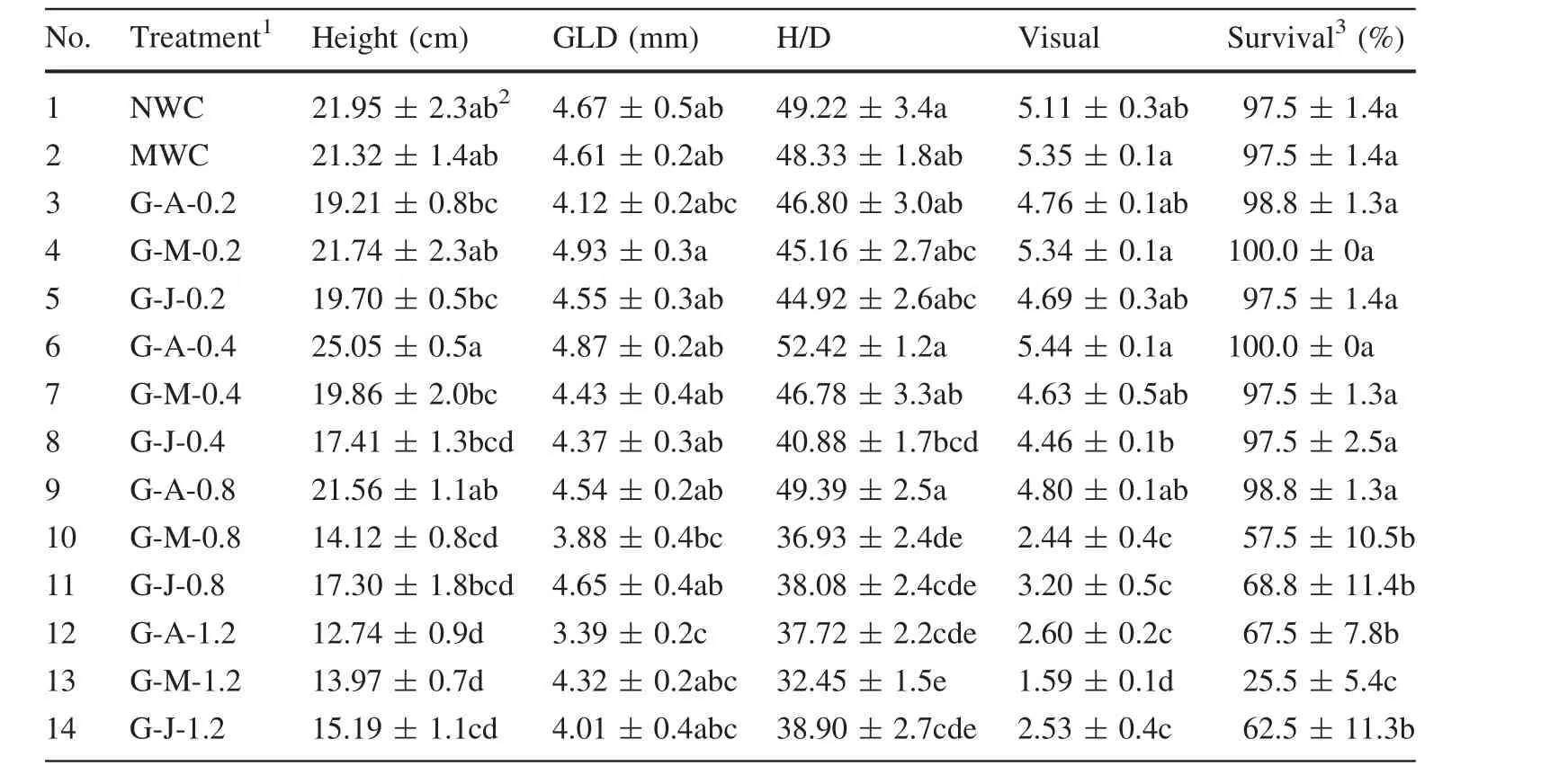
Table 4 Effects of weed control treatments on mean height(H),ground line diameter(GLD),vigor index(H/D)and visual health index at the end of the first growing season(Visual),and survival rate of seedlings of Pinus pinaster 1 year after treatment
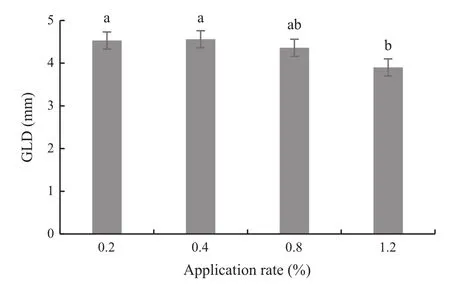
Fig.2 Effects of herbicide application rate on ground line diameter(GLD)of Pinus pinaster seedlings 1 year after treatment.Application rates showed signi ficant effect(p≤0.05).Means with different letters are significantly different(p≤0.05)
When only herbicide treatments were analyzed,a signi ficant AR effect was found for seedling survival(Fig.3).Mean seedling survival was considerably high for the low,intermediate,and high rates of glyphosate with no significant differences.Scots pine seedling mortality,however,significantly increased with the highest herbicide rate(Fig.3).
In addition,a signi ficant AR×AD interaction was found for the visual health index of the seedlings(Fig.4).Seedlings sprayed with the highest herbicide rate demonstrated the poorest health across all application dates.The rest of the ARs did not appear to in flict signi ficant damage on the seedlings except for the May treatments.With the May application at the high rate,the mean visual health index of the seedlings decreased significantly more than with the low-and intermediate-rate applications and was not significantly different from the health index at the highest AR(Fig.4).No signi ficant or interaction effect was found for the other seedling variables analyzed.
The correlation analysis demonstrated that application rate had a consistent,negative correlation with seedling visual health index and survival on the three application dates.In addition,increasing the application rate signi ficantly reduced seedling height and vigor index(H/D)in the May application(Table 3).
Conifers are reported to be tolerant to herbicides,including glyphosate at low rates(0.11%and 0.33%);however,this tolerance disappears at high rates(1%)(Tanjung 2001).This was shown in all the analyses in this study by consistent pine tolerance at the low and intermediate application rates(0.2 and 0.4%)and increasing phytotoxicity at higher rates,especially the highest rate(1.2%).
The varying sensitivity of young Austrian,maritime and,to a lesser extent,Scots pine seedlings to glyphosate application rates at various application dates in the present study,as indicated by consistently signi ficant AR×AD interactions,underlines the point that applying the treatment at the proper rate and time is key to controlling weeds effectively while maintaining crop safety(Newton and Knight 1981;Radosevich et al.2007).The increased herbicide phytotoxicity in the May application at the 0.8 and 1.2%rates in the present study con firms relevant past research indicating increased sensitivity of young conifer seedlings to foliar-applied glyphosate in the middle of the growing season when seedlings are physiologically themost active(Lund-Hoie 1975;Tanjung 2001;Kelpsas et al.2015).In another example,a Canadian study reported that glyphosate caused more injury to young seedlings of lodgepole pine(Pinus contortaDouglas ex Loudon),Douglas- fir(Pseudotsuga menziesii(Mirb.)Franco),and Engelmann spruce(Picea engelmanniiParry ex Engelm.)when applied in May,compared to September application at the end of the growing season(Tanjung 2001).Moreover,Yeiser and Ezell(2010)reported that glyphosate substantially injured young loblolly pine(Pinus teadaL.)seedlings in a plantation in the southern USA in mid-May,and recommended earlier applications of this herbicide for optimum weed control and crop safety.
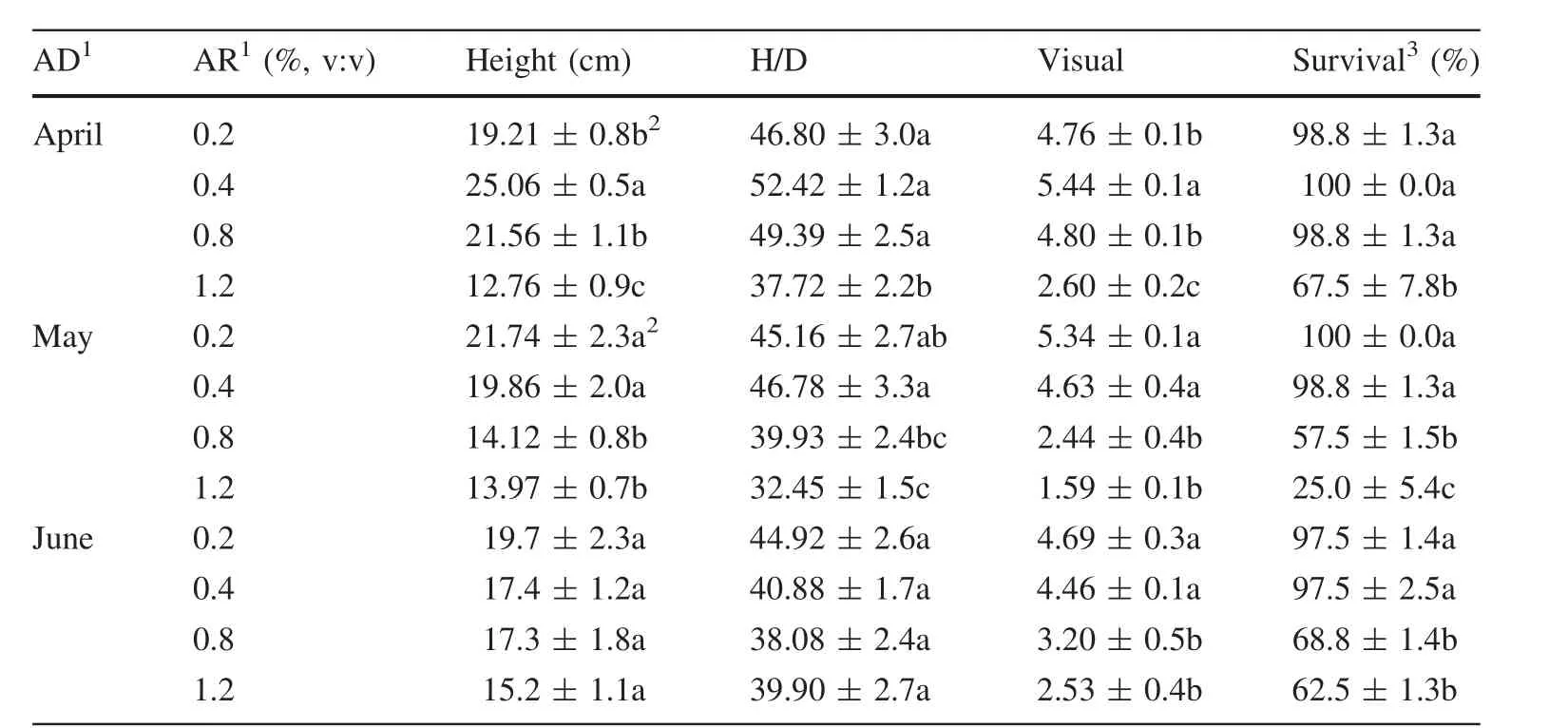
Table 5 Effects of herbicide application rate(AR)on mean height,vigor index(H/D),visual index at the end of the first growing season(Visual),and survival rate of Pinus pinaster seedlings by application dates 1 year after treatment
The epicuticular wax layer on leaf surfaces is the major barrier to many abiotic stresses for plant species,including high temperatures and irradiance,drought,altitude,cold and frost(Shepherd and Grif fiths 2006).The seasonal variation in the content and composition of the epicuticularwax layer(i.e.,the ‘‘leaf wettability’’)of conifer needles during the year also determines the seasonal differences in their tolerance to herbicides(Holloway 1970;Shepherd and Grif fiths 2006;Pallardy 2008;Wang et al.2015)by in fluencing herbicide uptake,translocation,and ef ficacy(Kirkwood 1999;Hess and Foy 2000).Wang et al.(2013)used the contact angle on the adaxial surface of cedar needles as a surrogate for leaf wettability and found that the contact angle at the end of May was lower(i.e.,the wettability and in turn,herbicide sensitivity was increased)than that at the end of April.Anfodillo et al.(2002)reported that the contact angle of the adaxial surface of recent and 1-year-old needles ofPinus cembraL.in Italy significantly decreased from February to August.In the present study,the seasonal variation in leaf wettability probably explains the variation in herbicide tolerance of the seedlings and their greatest sensitivity in May.

Table 6 Effects of various weed control treatments on mean height(H),ground line diameter(GLD),vigor index(H/D)and visual index at the end of the first growing season(Visual),and survival rate of Pinus sylvestris seedlings 1 year after treatment
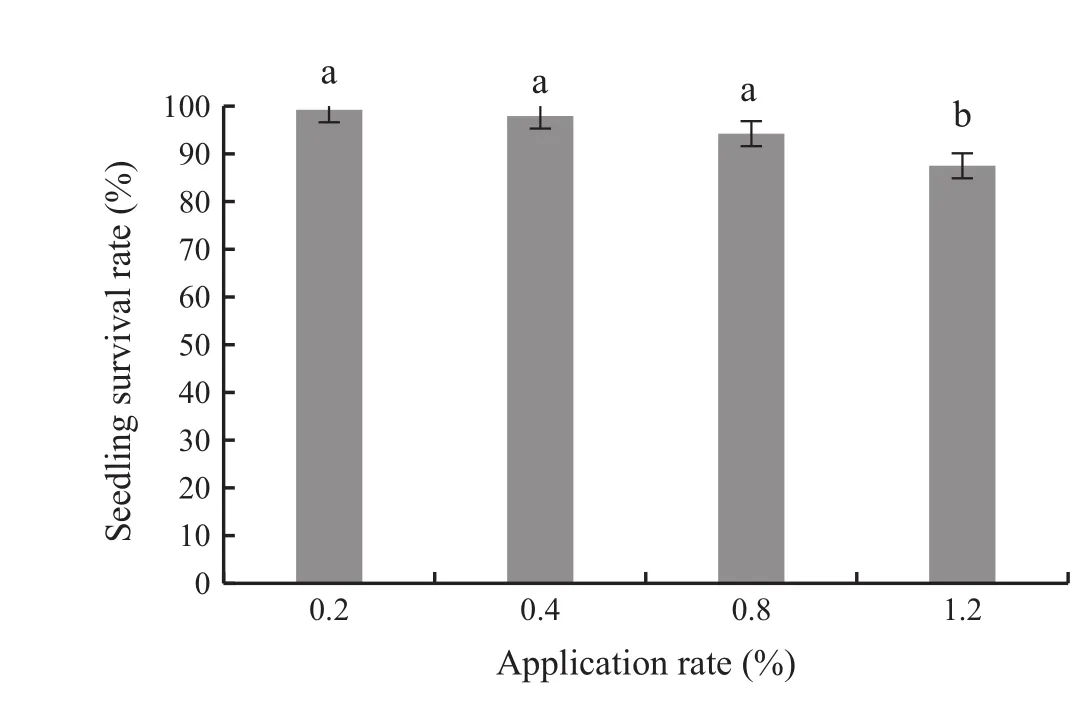
Fig.3 Effects of herbicide application on mean survival of Pinus sylvestris seedlings 1 year after treatment.A signi ficant herbicide application rate effect was found(p≤0.05).Means within the same column within the same year with different letters are significantly different(p≤0.05)

Fig.4 Effects of application rate by application dates on visual health index of Pinus sylvestris seedlings 1 year after treatment,based on the signi ficant application rate×date interaction effect(p≤0.05).Means within the same date with different letters are significantly different(p≤0.05)
Drought,low relative humidity,altitude,pollution and high solar radiation generally result in an increase in leaf wax content and inhibited herbicide uptake by plants(Cape 1983;Shepherd and Grif fiths 2006;Pallardy 2008).The pine species of the present study typically grow on sites where high irradiance and summer temperatures and low soil water availability are major issues(Genc¸2012).Lower leaf wettability due to a probable intrinsic increase in the leaf wax content in the seedlings in response to these abiotic stresses(Shepherd and Grif fiths 2006)might explain the slight increase in herbicide tolerance observed from May to June.
The relatively greater glyphosate tolerance of 3-year-old Scots pine seedlings when compared to 1-and 2-year-old Austrian and maritime pine seedlings,respectively,confirms previous reports that pine sensitivity to glyphosate is species-and age-speci fic(Prasad 1989;Tanjung 2001).Pine seedlings generally acquire more tolerance to glyphosate 1 year after establishment(Osiecka and Minogue 2014).Moreover,the greater epicuticular wax density in pine needles confers tolerance to abiotic stresses such as altitude,cold,frost,high irradiance and drought(Shepherd and Grif fiths 2006;Vilcˇinskas and Kupcˇinskien˙e 2012).Scots pine generally grows on south-facing slopes at higher elevations(Genc¸2012).In addition to higher age(Osiecka and Minogue 2014),the greater needle cuticle content of Scots pine as a possible adaption to frost and drought damage at high elevations(Shepherd and Grif fiths 2006;Vilcˇinskas and Kupcˇinskien˙e 2012)might be responsible for its greater herbicide tolerance compared to the other pine species.
Conclusions
The tolerance of young Austrian,maritime and Scots pine seedlings to foliar-applied glyphosate depended on the date and rate of application.In addition,the effects of application rates on seedlings varied according to application dates,i.e.,there was a signi ficant application rate×date interaction.Seedlings were tolerant to glyphosate at low and intermediate rates(0.2–0.4%v:v or 172–344 g a.i.ha-1),whereas they were extremely sensitive to glyphosate at the highest rate(1.2%v:v or 1032 g a.i.ha-1),resulting in substantial mortality and injury.Glyphosate tolerance at the rate of 0.8%v:v(689 g a.i.ha-1)varied according to application date.This rate is recommended only in the early mid-spring period when needles presumably have a dense leaf epicuticular wax layer providing limited herbicide penetration.Three-year-old Scots pine seedlings appear to have relatively greater glyphosate tolerance than Austrian and maritime pines.
AcknowledgementsThis study originated from the MSc thesis work of Mehmet Can Cap at Du¨zce University.We thank the Pınar Forest Nursery Management of Du¨zce Forest Directorate for their help in the study.
References
Anfodillo T,Bisceglie DPD,Urso T(2002)Minimum cuticular conductance and cuticle features ofPicea abiesandPinus cembraneedles along an altitudinal gradient in the Dolomites(NE Italian Alps).Tree Physiol 22:479–487
Anonymous(2014)Ormancılık istatistikleri 2014.Orman Genel Mu¨du¨rlu¨g˘u¨ (in Turkish).http://www.ogm.gov.tr/ekutuphane/Istatistikler/Ormanc%C4%B1l%C4%B1k%20%C4%B0statistik leri/Ormanc%C4%B1l%C4%B1k%20%C4%B0statistikleri%202014.rar.Accessed 03 Mar 2016(in Turkish)
Boydak M,C¸alıs¸kan S(2014)Ag˘ac¸landırma.OGEM-VAK Ankara,C¸ankaya,p 714
Bunn BH,Zedaker SM,Seiler JR(1995)Presoaking improves forest tree seed screening.In:Proceedings of the Southern Weed Science Society,Memphis,Tennessee,USA,pp 129–130
Cape JN(1983)Contact angles of water droplets on needles of Scots pine(Pinus sylvestris)growing in polluted atmospheres.New Phytol 93:293–299
Duryea ML,Landis TD(1984)Forest nursery manual:production of bareroot seedlings.Martinus Nijhoff/Dr W.Junk Publishers,The Hague,p 377
Es¸en D,Yıldız O(2000)Otsu ve odunsu diri o¨rtu¨mu¨cadelesinin mes¸cerelerin genc¸les¸tirilmesi ve bu¨yu¨mesine etkileri.TBMMO or Mu¨h Odası Der 37:28–32(in Turkish)
Es¸en D,Zedaker SM(2004)Control of rhododendron(Rhododendron ponticumL.andR. flavumDon.)in the eastern beech(Fagus orientalisLipsky)forests of Turkey.New For 27(1):69–79
Es¸en D,Yıldız O,Gu¨nes¸N,Sargıncı M(2006)Early susceptibility of hardwood tree seedlings to different post-emergent herbicides.J Balk Ecol 9(2):161–166
Es¸en D,Yıldız O,Edis¸S,Es¸en U,C¸etintas¸C(2012)Du¨zce’de glyphosate yaprak herbisitinin genc¸yabani kiraz(Prunus aviumL.) fidanlarına etkisi.DU¨Orman Der 8(1):50–57(in Turkish)
Ezel AW,Nelson L(2001)Weed control and crop tolerance after preemergent and postemergent applications of sulfomethuron in oak(Quercusspp.)plantations.Weed Technol 15:585–589
Genc¸M(2012)Silviku¨ltu¨ru¨n temel prensipleri.S.D.U.Orman Fak Yayın No:44,Isparta,p 351(in Turkish)
Hess FD,Foy CL(2000)Interaction of surfactants with plant surfaces.Weed Technol 14:807–813
Holloway PJ(1970)Surface factors affecting the wetting of leaves.Pestic Sci 1:156–163
Kelpsas B,Newton M,Landgren C(2015)Forestry.In:Peachey E(ed)Paci fic Northwest weed management handbook.Oregon State University,Corvallis,OR,p K-1–K-23
Kirkwood RC(1999)Recent developments in our understanding of the plant cuticle as a barrier to the foliar uptake of pesticides.Pest Sci 55:69–77
Lund-Hoie K(1975)N-phosphonomethylglycine(glyphosate),an alternative to commercial pre and postemergence herbicides for the control of unwanted plant species in forest plantation in Norway.Sci Rep Agric Univ Norway 55:1–14
McCarthy N,O’Reilly C(2001)The Impact of herbicides on tree seedling quality.COFORD Connects Reprod Material No:1,p 4 http://www.coilltenurseries.ie/notes/herbicide_impact.pdf.Accessed 19 June 2017
Mitchell PB,Zedaker SM,Seiler JR,Hipkins PL,Burch PL(2006)Evaluation of rapid screening techniques for woody plant herbicide development.Weed Technol 20:971–979
Newton M,Knight F(1981)Handbook of weed and insect control chemicals for forest resource managers.Timber Press,Beaverton Oregon,p 160
Osiecka A,Minogue PJ(2014)Considerations for developing effective herbicide prescriptions for forest vegetation management.FOR273,the School of Forest Resources and Conservation Department,UF/IFAS Extension,p 7,https://edis.ifas.u fl.edu/pdf files/FR/FR33500.pdf.Accessed 03 Mar 2016
Ott RL(1993)An introduction to statistical methods and analysis,4th edn.Duxberry Press,Belmont,California,p 1051
Pallardy SG(2008)Physiology of woody plants,3rd edn.Academic Press,Amsterdam,p 454
Prasad R(1989)Crop tolerance of three west coast conifer species to glyphosate.In:Reynolds PE(ed)Proceedings of the Carnation Creek Herbicide Workshop.Paci fic Forestry Centre,Victoria,BC,Canada,pp 189–196
Radosevich SR,Holt JS,Ghersa CM(2007)Ecology of weeds and invasive plants:relationship to agriculture and natural resource management,3rd edn.Wiley,New Jersey,p 472
Ross MA,Lembi CA(1989)Applied weed science.MacMillian and Collier MacMillian,New York,p 340
Saatc¸iog˘lu F(1957)Karadeniz ormanları su¨ceyrat:Ayancık-Cangal bo¨lgesinde mekanik metodla yapılan su¨ceyrat mu¨cadelesine ait 12 yıllık tecru¨be denemeleri.J Faculty of Forestry Univ of Istanbul 7:69–108(in Turkish)
SAS Institute Inc(2008)SAS/STAT®9.2 User’s guide.SAS Institute,Cary,NC,p 16
Shepherd T,Grif fiths DW(2006)The effects of stress on plant cuticular waxes.New Phytol 171(3):469–499
Stanley W,Zedaker S,Seiler J,Burch P(2014)Methods for rapid screening in woody plant herbicide development.Forests 5:1584–1595
Tanjung RHR(2001)Effects of glyphosate on seedlings of conifer and broadleaf trees species native to British Columbia,with particular regard to root-fungus interactıons.Ph.D.Dissertation,Simon Fraser University,Canada,p 184
Thompson DG,Pitt DG(2003)A review of Canadian forest vegetation management research and practice.Ann For Sci 60:559–572
Vilcˇinskas R,Kupcˇinskien˙e E(2012)Seasonal dynamics of histological parameters of the needles of Scots pine(Pinus sylvestrisL.)growing in conditions of excess ammonia.Biologija 58(1):27–36
Wagner RG,Newton M,Cole EC,Miller JH,Shiver BD(2004)The role of herbicides for enhancing productivity and conserving land forbiodiversity in North America.WildlSoc B 32(4):1028–1041
Wang H,Shi H,Li Y,Zhang J(2013)Seasonal variations in leaf capturing of particulate matter,surface wettability and micromorphology in urban tree species.Front Environ Sci Eng 7(4):579–588
Wang H,Shi H,Wang Y(2015)The wetting of leaf surfaces and its ecological signi ficances.In:Aliofkhazraei M(ed)Wetting and wettability.Chapter 11.InTech Publ,Rijeka,pp 295–321
Willoughby I,Clay D,Dixon F(2003)The effect of pre-emergent herbicides on germination and early growth of broadleaved species used for direct seeding.Forestry 76(1):83–94
Woeste KE,Seifert JR,Selig MF(2005)Evaluation of four herbicides and tillage for weed control on third-year growth of tree seedlings.Weed Sci 53:331–336
Yeiser JL,Ezell AW(2010)Split-season herbaceous weed control for full-season seedling performance.In:Stanturf JA(ed)Proceedings of the 14th biennial southern silviculture research conference generaltechnicalreportSRS-121.Deptartmentof Agriculture Forest Service,Southern Research Station,Asheville,NC,US,pp 131–138
Yildiz O,Es¸en D(2006)Effects of different rhododendron control methods in eastern beech(Fagus orientalisLipsky)ecosystems in the Western Black Sea Region of Turkey.Ann App Biol 149(2):235–242
Yildiz O,Sarginci M,Es¸en D,JrK Cromack(2007)Effects of vegetation control on nutrient removal andFagus orientalisLipsky regeneration in the Western Black Sea Region of Turkey.For Ecol Manag 240(1–3):186–194
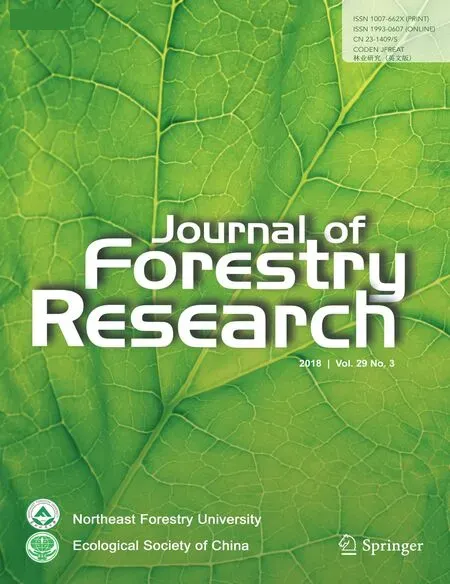 Journal of Forestry Research2018年3期
Journal of Forestry Research2018年3期
- Journal of Forestry Research的其它文章
- In vitro propagation of conifers using mature shoots
- ‘Relationships between relationships’in forest stands:intercepts and exponents analyses
- Assaying the allelopathic effects of Eucalyptus camaldulensis in a nursery bed incorporated with leaf litter
- Effects of soil compaction on growth variables in Cappadocian maple(Acer cappadocicum)seedlings
- Variation and selection analysis of Pinus koraiensis clones in northeast China
- Non-aerated liquid culture promotes shoot organogenesis in Eucalyptus globulus Labill
